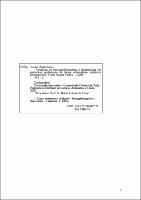| Compartilhamento |


|
Use este identificador para citar ou linkar para este item:
http://tede2.pucgoias.edu.br:8080/handle/tede/3042| Tipo do documento: | Dissertação |
| Título: | PESQUISA DE HEMOGLOBINOPATIAS E TALASSEMIAS EM PACIENTES PORTADORES DE LÚPUS ERITEMATOSO SISTÊMICO. |
| Autor: | Castro, Frank Sousa  |
| Primeiro orientador: | Silva, Nilzio Antônio da |
| Resumo: | 13 O Lúpus Eritematoso Sistêmico é uma doença tipicamente multigênica e multifatorial, com grande complexidade clínica e fisiopatológica. As causas do LES não são totalmente conhecidas, mas sabe-se que fatores ambientais e genéticos estão envolvidos. As manifestações clínicas observadas em pacientes acometidos pelo LES são diversificadas como fadiga, mal-estar, emagrecimento, artrite, febre, nefrite, vasculite e anemias. Dentre as várias manifestações clínicas observadas em pacientes com Lúpus, as anemias nos chamam a atenção principalmente quando se observa em nosso estudo uma prevalência 52,5% dos pacientes com índices hematimétricos sugestivo de anemias. Esse quadro de anemia normalmente se observa em pacientes com doença lúpica, mas sobre as anemias hereditárias, em especial as hemoglobinopatias e talassemias, que são as mais comuns das alterações genéticas humanas de freqüência muito variável na população brasileira, têm poucos estudos realizados de prevalência nas populações acometidas por LES. O objetivo desse trabalho foi o de avaliar a prevalência das hemoglobinopatias e talassemia em pacientes portadores de Lúpus Eritematoso Sistemica. Para isso foram estudadas 80 amostras de sangue de pacientes com doença Lúpica atendidos no ambulatório do Hospital das Clinicas de Goiânia. Foram utilizados testes laboratoriais não moleculares. A freqüência das alterações da hemoglobina foi de 8,75%, encontradas em 7 pacientes. Dessas alterações a mais prevalente foi a talassemia alfa, encontrada em 4 pacientes, correspondendo a uma freqüência de 5,0% da população estudada. A segunda alteração mais freqüente foi o heterozigoto para a hemoglobina S, encontrada em 2 pacientes, correspondendo a 2,5% da população. A terceira alteração foi o heterozigoto para a hemoglobina C, encontrada em 1 paciente, correspondendo a 1,25%. Nenhum caso de homozigose foi encontrado no presente estudo. Este trabalho demonstra a necessidade de avaliações mais cautelosas nos distúrbios das anemias em pacientes com Lúpus, sugerindo a implantação de serviços hematológicos de esclarecimento a essa população com o intuito de esclarecer a verdadeira causa da anemia presente nos indivíduos afetados com LES. |
| Abstract: | 15 Systemic Lupus Erythematosus is a quintessential multigenic and multifactorial disease, with remarkable clinical and pathogenic complexities. The causes of the SLE total are not known, but it knows that ambient and genetic factors are involved. The observed clinical manifestations in patients to take hold of the SLE are diversified as fatigue, indisposition, slimming, arthritis, fever, nephritis, vasculitis, and anemias. Amongst them you various observed clinical manifestations in lupus patients, the anemias in them call the attention mainly when prevalence 52.5% of the patients with RBC index suggestive of anemias is observed in our study. This picture of anemia normally is observed in lupus patients, but the hereditary anemias, especially the hemoglobinopathies and thalassemias, are the most common of the human genetic alterations and its frequency in the Brazilian population is very variable, have few carried through studies of prevalence in the populations attacks for SLE. In an attempt to evaluate the prevalence of the hemoglobinopathies and thalassemia in the population with systemic lupus erythematosus. We studied 80 blood samples of patients with systemic lupus erythematosus in the Hospital das Clinicas de Goiânia-Brazil had been studied. Laboratories tests had been used but not molecular tests. The frequency of the alterations of the hemoglobin was 8.75%, found in 7 patient. Of those alterations, the more prevalent was the thalassemia alpha, found in 4 patient, corresponding to a frequency of 5.0% of the studied population. The second more frequent alteration was the heterozigous for the hemoglobin S, found in 2 patients, corresponding to 2.5% of the population. The third alteration was the heterozigous for the hemoglobin C, found in 1 patient 1.25%. No case of homozigose was found in the present study. This study demonstrates hemoglobinopathies and thalassemia be include between several cause of anemia in SLE. |
| Palavras-chave: | LÚPOS ERITEMATOSO SISTÊMICO HEMOGLOBINOPATIA TALASSEMIA ANEMIA |
| Área(s) do CNPq: | CNPQ::CIENCIAS DA SAUDE |
| Idioma: | por |
| País: | BR |
| Instituição: | Pontifícia Universidade Católica de Goiás |
| Sigla da instituição: | PUC Goiás |
| Departamento: | Ciências da Saúde |
| Programa: | Ciências Ambientais e Saúde |
| Citação: | CASTRO, Frank Sousa. PESQUISA DE HEMOGLOBINOPATIAS E TALASSEMIAS EM PACIENTES PORTADORES DE LÚPUS ERITEMATOSO SISTÊMICO.. 2005. 92 f. Dissertação (Mestrado em Ciências da Saúde) - Pontifícia Universidade Católica de Goiás, Goiânia, 2005. |
| Tipo de acesso: | Acesso Aberto |
| URI: | http://localhost:8080/tede/handle/tede/3042 |
| Data de defesa: | 5-Dez-2005 |
| Aparece nas coleções: | Mestrado em Ciências Ambientais e Saúde |
Arquivos associados a este item:
| Arquivo | Descrição | Tamanho | Formato | |
|---|---|---|---|---|
| FRANK SOUSA CASTRO.pdf | 1,31 MB | Adobe PDF |  Baixar/Abrir Pré-Visualizar |
Os itens no repositório estão protegidos por copyright, com todos os direitos reservados, salvo quando é indicado o contrário.




